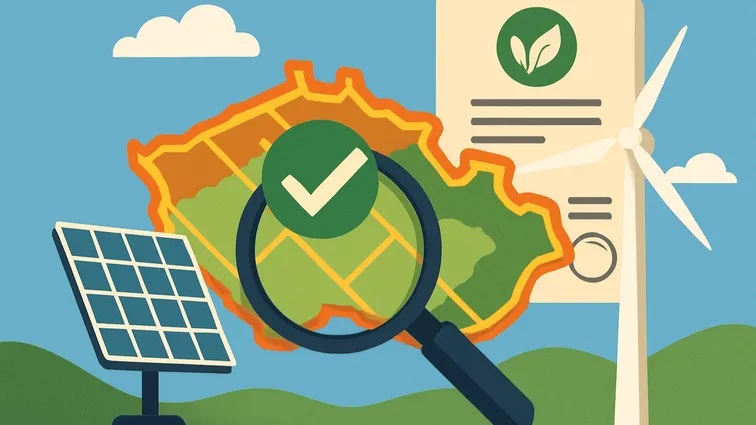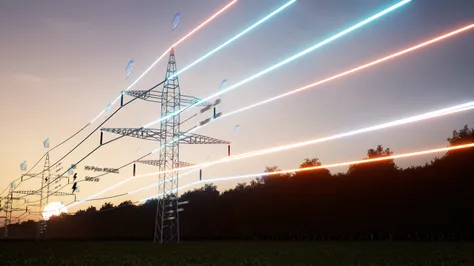A new Czech law, Act No. 249/2025 Coll., on the Acceleration of the Use of Renewable Energy Sources, introduces the concept of so-called ‘acceleration zones’ into national legislation.
These zones are designated areas where the approval process for constructing facilities that use renewable energy sources (RES) is expected to be significantly faster than before. Investors will be able to obtain the necessary administrative permits for their projects in these zones within substantially shortened timeframes—ideally within one year of submitting their application for project permit, compared to the current multi-year process. The Act came into effect on 1 August 2025. However, implementing legislation is still pending.
Legal framework and process for defining acceleration zones
An acceleration zone is an area designated to accelerate the use of RES. Such a zone must fall within a broader “essential area” defined by the Czech government in its Territorial Development Policy for the specific type of a renewable energy source. Outside these essential areas, acceleration zones cannot be declared.
Criteria for defining an acceleration zone include the suitability of the location[1], with the aim of minimizing negative impacts on surrounding areas in terms of land use limits.
Under the new legislation, acceleration zones can be proposed not only by municipalities and regional authorities, but also by the State itself (the government) within the framework of national land use planning documentation. In cases where land use plans conflict, higher-level documentation takes precedence: regional plans override municipal ones, and national plans take priority over regional ones.
Acceleration zones are defined as part of land use planning at three levels:
- Local-level zones are defined by municipalities in their land use plans;
- Regional-level zones are defined in the regional land development policy; and
- National-level zones may be defined directly in the National Land Development Plan.
The Act stipulates a coordinated process for preparing acceleration zones, which includes a thorough assessment of all public interests in advance.[2] For each zone there must be issued a territorial measure specifying the conditions and mitigation requirements for projects within the zone—such as limits on installed capacity, technical noise reduction measures, or protective buffer distances.
Construction of RES facilities under the new accelerated regime will only be possible once an acceleration zone has been officially defined. This means there may be a delay between the new Act’s entry into force and the actual implementation of projects based on it.
Permitting process and project implementation in acceleration zones
Individual RES projects within acceleration zones will still undergo the “standard” permitting process under the Building Act, but with substantial adjustments aimed at accelerating the entire permitting process. RES projects that meet the set criteria will not be required to undergo a full Environmental Impact Assessment (EIA); instead, they will only need to obtain a positive Single Environmental Opinion (SEO). Administrative authorities are required to prioritize RES projects in acceleration zones, processing them within shortened timeframes and limiting opportunities for appeals and judicial reviews of selected actions to avoid procedural delays. The Act aims for the entire process—from application submission to permit issuance—to ideally take no longer than one year. However, investors must also account for the time needed to prepare documentation, including project design, materials for the SEO, property rights settlement, and grid connection.
Acceleration zones are open for project implementation to all investors who meet the required conditions and obtain the necessary administrative permits. These zones are not reserved for any single investor; on the contrary, they are designed to foster competition. Any entity whose project meets the parameters defined in the territorial measure of an acceleration zone may implement its project in the given territory. When an acceleration zone is declared, the land use plan must specify the type of primary energy source for which the zone is designated —such as an acceleration zone designated for wind power plants. Once the zone is defined and the territorial measure with conditions is issued, any investor may apply for the necessary administrative permits for their specific project within the zone. No additional special authorisation is required to enter the acceleration zone.
However, acceleration zones do not automatically guarantee grid capacity. Existing rules for grid connection—such as those under the Energy Act and the regulations of the distribution system operator—remain in force, although methodological preferences for RES projects within acceleration zones can be expected.
Summary of benefits of acceleration zones for RES projects
RES projects that meet the required conditions are exempt from undergoing a full Environmental Impact Assessment (EIA) in relation to an acceleration zone. Projects within acceleration zones are assessed preferentially, and administrative authorities process them with higher priority than comparable projects outside the zones.
The Act also shortens various deadlines for issuing opinions and decisions and limits the scope for appeals and judicial reviews of selected actions to prevent procedural delays.
Additionally, the validity of a positive SEO for energy projects is now extended from 5 to 7 years.
New revenues for municipalities from RES
The new Act also brings financial benefits for municipalities.
Electricity producers operating wind power facilities must now pay a fee to the municipality based on the amount of electricity generated (minus technological self-consumption), set at CZK 50 per 1 MWh.
Acceleration zones represent a crucial and much-needed instrument to help “unblock” the construction of renewable energy sources in the Czech Republic—particularly wind farms. If well-selected and fully utilized, these zones could become a driving force for faster achievement of energy and climate goals, while also making clean electricity more accessible to households and businesses.
Our Energy Law team at HAVEL & PARTNERS will be closely monitoring the implementation of this new legislation and is ready to provide you with legal support in the development of your energy projects.
- [1] – Acceleration zones cannot be established in national parks, protected landscape areas, Special Areas of Conservation and Special Protection Areas under NATURA 2000, or other specific territories that the government may exclude due to nature conservation, heritage protection, national defence, spa operations, or aviation concerns. Priority is given to land that has already been degraded or affected by human activity—such as industrial sites, areas near highways and railways, parking lots, landfills, spoil heaps, unreclaimed mining areas, and artificial water bodies.
- [2] – Before an acceleration zone is officially declared, several evaluations must be carried out. These include an assessment of impacts on sustainable territorial development, a strategic environmental assessment (SEA), biological territorial evaluations, and obtaining opinions from the public authorities concerned.









